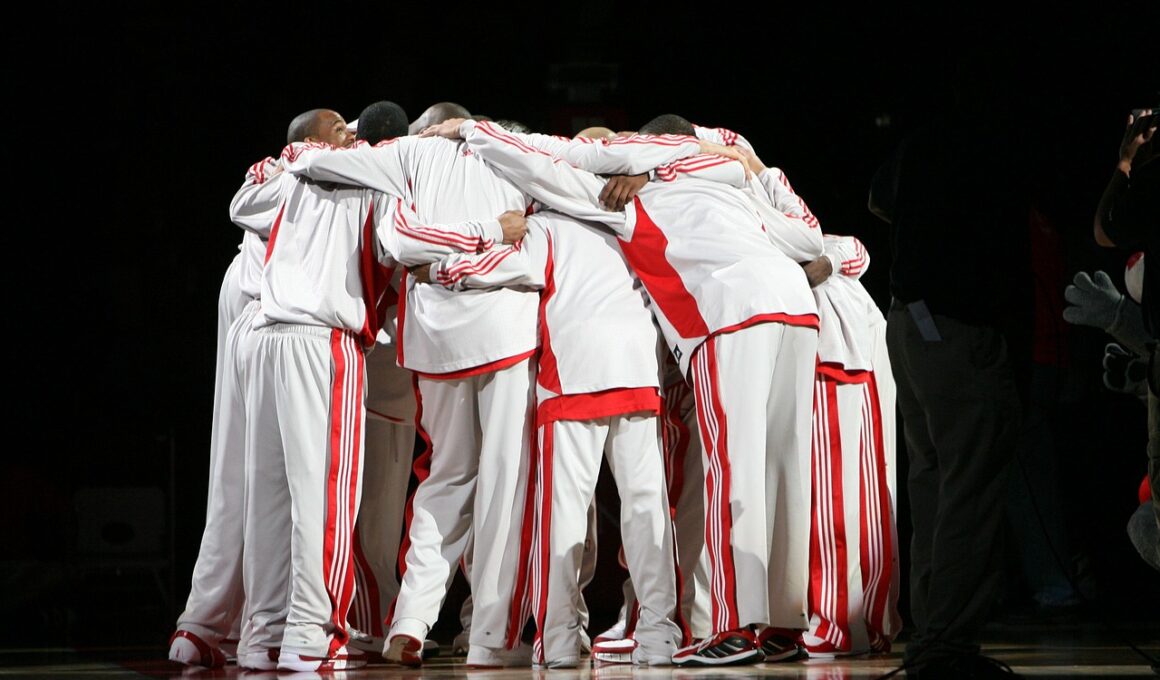Top 10 Broomball Drills to Improve Your Team’s Performance
Broomball, a highly engaging ice-based sport, requires a blend of speed, agility, and teamwork. To enhance your team’s performance, implementing effective drills is crucial. The first drill focuses on stick handling, which enhances control on the ice. Players should practice weaving between cones while maintaining control over their broomballs. This not only improves individual skills but also encourages spatial awareness in team settings. Next, consider incorporating passing drills that promote accurate and quick passes. Have players line up and pass in a quick sequence, emphasizing wrist control and proper posture to avoid injuries. Following passing, shooting drills can significantly enhance scoring chances. Encourage players to practice shots from various angles and positions on the rink. An effective drill is to set up targets in the goal, stimulating competition among players. Consistent repetition of these fundamental skills builds player confidence as they progress. Additionally, integrating agility drills helps improve footwork, crucial for faster movements. Ladder drills are excellent for enhancing agility, enabling players to perform swift directional changes, similar to what is required in an actual game.
A drill that combines agility and teamwork is the relay race. Divide players into teams and set up a course requiring them to carry a broomball between them. This drill not only develops speed but also emphasizes communication and teamwork among players. Ensure players are encouraged to strategize regarding the best approach to navigating the relay. Following the relay, a defensive positioning drill is important for teaching players how to maintain proper distance from the opposing team. This is crucial during game scenarios when quick decisions are made. Players should practice staying within their zones while maintaining awareness of their teammates. Utilizing scrimmages can also be beneficial in honing skills learned during drills. Regularly scheduled scrimmages allow players to apply their skills against one another in a controlled environment. Capture these opportunities to reinforce good habits and correct poor ones dynamically. Furthermore, implementing goalkeeping drills is essential, regardless of whether the players play that position. Understanding the basics of goingaltending, including positioning and angles, helps players appreciate their teammates’ roles. This appreciation builds a more cohesive team unit, improving overall performance.
Incorporating fitness and endurance training into your routine is imperative for overall performance improvement. Drills should include sprinting exercises that mimic the short bursts of speed seen in games. Intervals of sprinting and rest build stamina and power which are critical in broomball. The fitness drills must also include strength training, particularly focused on the legs to enhance skating power. Strong legs are vital for powerful pushes and quick stop-start movements necessary for both offense and defense. Moreover, discuss and emphasize the importance of off-ice training as it translates directly to on-ice performance by building muscle memory and enhancing physical strength. Incorporating plyometric exercises will help athletic performance by improving explosive strength. Box jumps, in particular, are a fantastic plyometric that builds leg strength and power. Finally, conclude your training routines with cooldown drills to prevent injuries. Stretching post-training is essential as it aids in muscle recovery and maintains flexibility. Including this aspect of training makes sure players can perform during their matches without dealing with soreness. These consistent training elements develop a well-rounded player ready to excel in competitive situations.
Competitive Drills for Team Cohesion
To foster team cohesion, competitive drills can motivate players and enhance overall spirit. One effective drill is the three-on-two scenario, where three attackers face two defenders. This setup encourages teamwork usage, as attackers must strategize to outmaneuver the defenders while defenders work on coordination. Implementing scenarios that mimic game pressure prepares players for real situations during matches, making them adapt to the dynamics quickly. Another competitive drill is the capture-the-flag style game where teams must steal a flag while protecting their own. This drill cultivates trust among players, promoting collaboration. Additionally, incorporating variations of gameplay into your drills encourages players to think strategically. Allow players to assume different roles and responsibilities periodically. This versatility not only develops skills but also creates understanding and appreciation for various team positions. Keeping the atmosphere friendly yet competitive enhances motivation and enjoyment. Every player should feel integral to the team’s success, and fostering this spirit will reflect in actual games. Furthermore, ensure that skill evaluations are conducted to provide feedback regularly. Incorporating constructive feedback within your frameworks fosters a culture of improvement both individually and collectively.
The integration of technology in broomball training is becoming more prevalent. Tools such as filming devices can capture player movements, thereby allowing for thorough analysis. Reviewing footage allows players to identify areas needing improvement, which enhances skill development. Coaches should also use various software to analyze performance metrics over time. Creating visually appealing presentations of progress can motivate players and show the benefits of hard work. Another modern method involves simulation drills where players use virtual reality setups to mimic game scenarios without physically being on the rink. These simulations help enhance decision-making skills and situational awareness, essential components of competitive play. Additionally, consider employing strength and conditioning coaches to improve fitness levels specific to broomball needs. Personalized training plans can address players’ individual weaknesses ensuring that each player works towards maximizing their potential. Synthesizing these technological advancements enhances your training methodologies, keeping your team on the cutting edge. Combining traditional drills with innovative technology fosters a culture of continual growth, which is vital for long-term success in the sport.
Conclusion: Committing to Practice
In conclusion, repeated practice coupled with a positive team environment is essential to improving overall performance in broomball. By implementing a variety of drills tailored to your team’s needs, players enhance their skillsets differently. Monitoring progress consistently through drills should become a team habit. Celebrating small successes fosters a positive atmosphere, which is essential for teamwork. Building resilience among players must remain a priority, ensuring they understand that improvement comes from overcoming challenges. Coaches should remain adaptable and responsive to the players’ evolving needs. Experimenting with unique drills and integrating players’ suggestions can create a sense of ownership and responsibility within the team. Further, as players gain confidence in their skills, they expand their team roles leading to a well-rounded and effective roster. Ensure you engage players in discussions about their experiences and take their feedback seriously. This strategy nurtures open communication that promotes a strong team bond. Thus, as you continue to implement and refine these drills, aim to cultivate a culture of excellence, one where teamwork and continuous improvement blend beautifully to achieve success in broomball. Regular practice will ultimately drive your team toward victory.
Final takeaway: remember that improvement takes time and commitment. Establish clear goals for your team, guiding their training processes. By creating structured yet engaging training sessions, you empower your players to strive for excellence. Emphasize the importance of enjoying the game as an essential part of their growth. Always encourage players to find joy in mastering their skills and enjoy the camaraderie that comes with teamwork. Embrace the journey of developing a cohesive and qualified broomball team. Happy practicing!
Broomball, much like other team sports, relies heavily on effective communication on the ice. Implementing a consistent terminology for plays and strategies fosters better understanding amongst teammates. Regular huddles before practice or games are beneficial. This allows for clear communication of strategies and critiques from coaches. Players should feel encouraged to share insights on things that work or things that don’t. Fostering a safe space for discussion ensures everyone’s voice is heard, leading to better team dynamics. Establishing a shared mental model will propel your team’s performance forward. The synergy developed from a well-communicated approach not only aids performance but also creates lasting relationships among team members. This camaraderie becomes invaluable during high-pressure situations. Community is built through support and shared experiences on the ice. Remember the essential aspects of fun and enjoyment in every practice and game, as these elements keep the players motivated. Eventually, this interconnectedness drives the team to perform better collectively on the rink, enhancing the sport’s overall appeal. It comes down to creating experiences that players will cherish long after they leave the rink.


